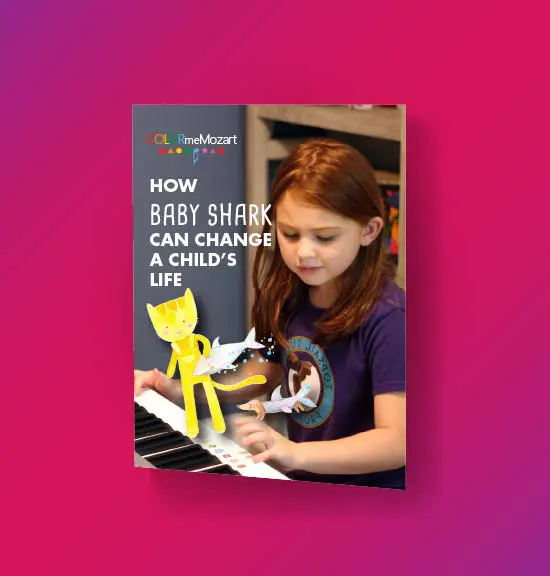Are you looking for a way to add more joy and creativity to your homeschool day without adding stress to your schedule? Music is an amazing addition to any homeschool routine, and finding easy music lessons for homeschool can make all the difference for busy families. This guide offers simple, practical ways to make music a daily part of your homeschool routine, even if you’re not a musician yourself. Ready to begin a complete music curriculum for you and your family? Check out our Color Me Mozart™ homeschool music curriculum here.
Whether your children are toddlers or teens, you’ll find ideas here to help them connect with music daily, building lifelong skills and a love for learning along the way.
1. Start with a Morning Music Moment
Begin your day with a short, enjoyable activity from easy music lessons for homeschool families to get everyone energized. This sets a positive tone for the day and helps kids get energized and ready to learn. Here are some ways to incorporate music in the morning:
- Song of the Day: Pick a song that reflects the theme or mood you’d like to set. Play it while your kids settle in for schoolwork or even while they have breakfast. You could vary it by genre or by choosing songs from different cultures.
- Quick Rhythm Drills: Hand-clapping, finger-snapping, or simple rhythm exercises can engage kids and help them focus. You can even use everyday items like pencils or cups for a quick beat.
- Instrument Warm-Ups: If you have a keyboard, xylophone, or simple percussion instruments, a quick morning warm-up can become a fun routine that builds musical familiarity and comfort.
2. Make Music Listening Part of Learning
Adding music to other subjects is one of the easiest ways to keep up with easy music lessons for homeschool, especially when you’re busy.
- History and Culture Lessons: Choose music from the historical periods or cultures you’re studying. If you’re learning about Ancient Egypt, for example, look up traditional Middle Eastern music. This way, music becomes a natural part of your day’s learning without adding another full lesson.
- Science and Nature Themes: When studying nature, play pieces like Vivaldi’s Four Seasons or other music inspired by the natural world. This adds depth to the lesson and allows kids to experience science topics through music.
- Math Concepts with Rhythm: Teach basic math concepts, such as fractions and counting, by clapping or tapping rhythms. Dividing beats into halves, quarters, and eighths can give kids a tangible understanding of division and fractions.
3. Create a Musical Storytime
Many homeschool families already incorporate read-aloud time into their day, so adding a musical element can enhance this routine. Try these ideas:
- Soundtrack to a Story: Play instrumental music that matches the mood of the story you’re reading. If it’s a mystery or adventure, add a suspenseful background track. Kids will love the immersive experience, and it opens up discussions about how music affects emotions.
- Musical Character Voices: When reading dialogue, assign characters different vocal “instruments.” Maybe the big, brave knight has a deep drumbeat voice, while the delicate princess sounds like a high-pitched flute. It’s a fun way to show how pitch and tone can convey personality.
4. Try Easy Music Games for Homeschool Breaks
Turn breaks into quick, fun music sessions that feel like play but build important skills. Here are a few simple music games you can try:
- Rhythm Copycat: Tap a rhythm on the table and have your child repeat it back to you. Start simple, and then build to more complex rhythms as they get the hang of it.
- Freeze Dance: Play a favorite song and let your kids dance. When the music stops, they have to freeze in place. It’s an easy way to encourage movement and musical timing.
- Guess the Sound: Use a small keyboard or app to play a few notes, and have your child guess if the notes are high, low, or in the middle. This game helps kids understand pitch and is especially engaging for younger learners.
5. Designate a Simple “Instrument Practice Time” Each Day
Incorporating instrument practice doesn’t have to mean lengthy or complicated lessons. Set aside a 5-10 minute daily block for instrument exploration. Here are some ideas:
- Keyboard Practice: If you have a keyboard, teach your child the basics, such as pressing middle C or identifying notes. Our curriculum will guide you and your child on how to learn all the notes on the keyboard.
- Rhythm Instruments: Have rhythm instruments like tambourines, shakers, or drums available. You can keep them in a basket for kids to pick up and play along to songs.
- Xylophone for Young Learners: A Color Me Mozart™ xylophone is a perfect beginner instrument for younger kids, allowing them to explore notes and scales without needing advanced motor skills.
6. Make Music a Family Activity
Music brings people together, and that includes your family! You don’t need to be an expert musician to create meaningful musical experiences together.
- Family Sing-Alongs: Pick a few favorite songs and sing together. It doesn’t have to be perfect; it’s about the joy of creating music as a family.
- Home Concerts: Have your kids perform their own mini-concerts, even if it’s just playing a simple melody on the keyboard or xylophone. This builds confidence and gives them a goal to work toward.
- Musical Challenges: For older kids, try musical challenges like learning the melody of a new song in a week or composing a simple tune. Celebrate their progress together, even if they only master a small part.
7. Celebrate Progress and Keep It Light
Remember, the goal is to make music a fun, enriching part of your homeschool routine, not to create stress. A few final tips:
- Encourage Effort Over Perfection: Celebrate small wins, like learning a new rhythm or mastering a few notes. This keeps kids motivated and makes learning enjoyable.
- Let Kids Lead Sometimes: Allow your child to pick the songs, rhythms, or activities once in a while. This gives them a sense of ownership and keeps things fresh.
- Keep It Flexible: Some days, music might be a major focus; other days, it might just be a quick song. Flexibility helps music fit into a busy homeschool day without overwhelming anyone.
Final Thoughts
Adding music to your homeschool doesn’t need to be time-consuming or complicated. With “easy music lessons for homeschool”, you can integrate music into your day in small, manageable ways. Whether it’s a morning music session, an instrument exploration, or a quick rhythm game, each little bit contributes to your child’s overall growth and love for music. Embrace the joy and creativity that music brings, and make it a daily highlight in your homeschool journey.




